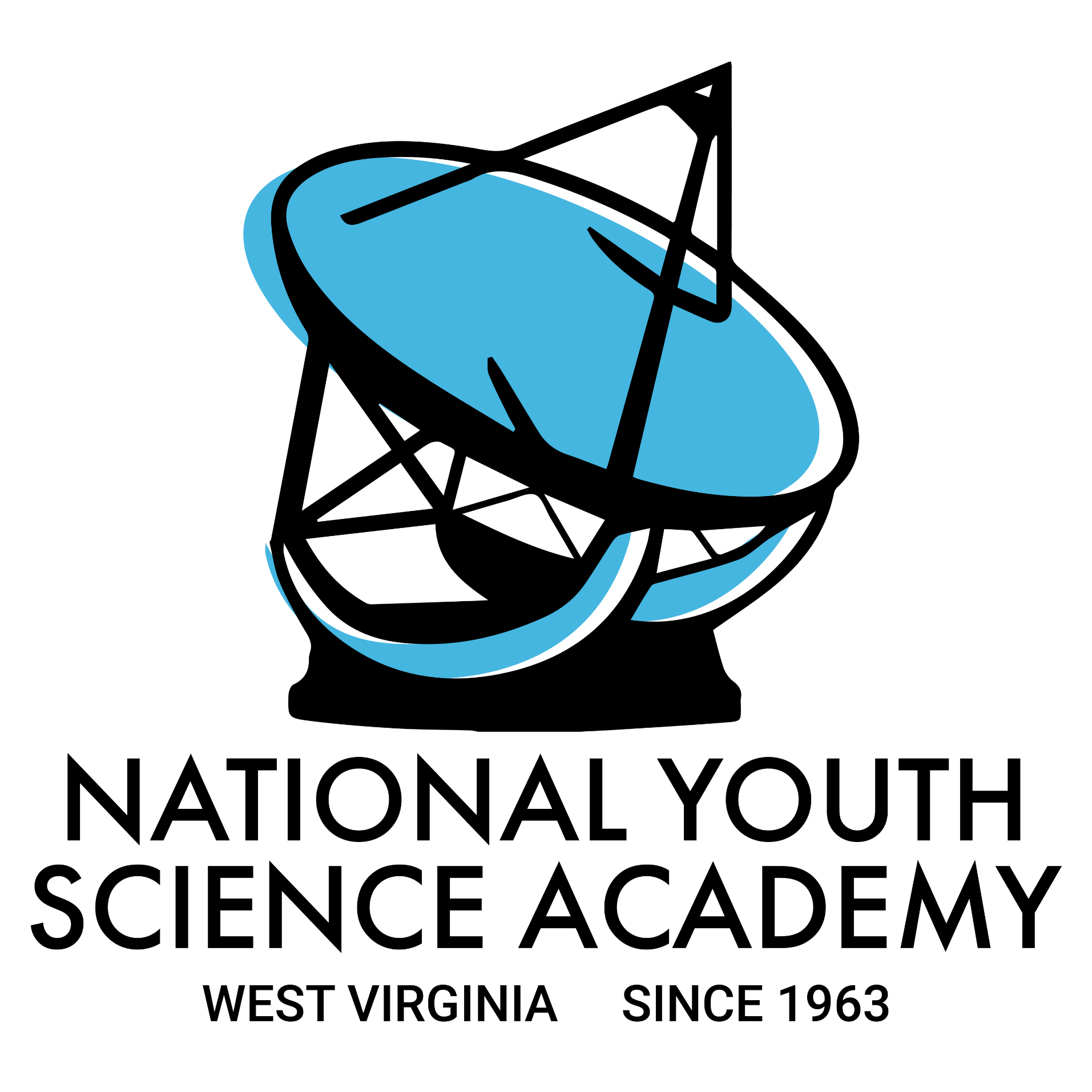Alumni make financial donations to the National Youth Science Foundation (NYSFoundation) to honor and recognize fellow alumni and friends of the Foundation and their unwavering passion for science. Those who have been memorialized are listed below.
If you would like to honor a friend or fellow alumnus with a donation in their name, please designate your request by emailing donate@nysf.com.
Mrs. Deb Hackleman
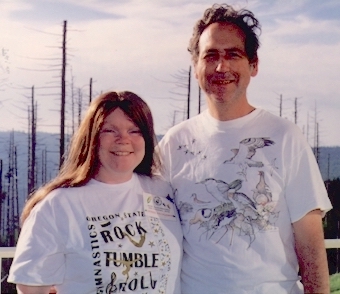
For the past 37 years, Deb Hackleman supported her husband Dave as he has served on the NYSCamp staff, as a presenter, conducted directed studies, contributed significantly to development activities, and was one of the founders of the Adler Fund and the Alumni Board. He served for a year as a volunteer fundraiser and is a vital and distinguished member of the Board of Trustees. Deb’s recent passing has left a hole in Dave’s heart and in the NYSCamp. Until this year, I presented at Camp for over thirty years and have spent many an early morning sitting on the Laura-Dill front porch talking with Deb, Dave, Camp staff, and delegates. Dave and Deb alike were sought out by delegates as breakfast, lunch, and dinner partners and could frequently be found talking to a group of delegates during free time and after lectures. Their long-term, continuous support deserves meaningful, long-term recognition. In that, a women’s cabin at the new NYSCamp shall be named the Deb and Dave Hackleman Cabin to provide them with the recognition they have earned for their numerous contributions to the Foundation and Camp.
-Mac
“I clearly remember Deb every summer at NYSCamp in the Laura Dill Dining Hall at meals interacting with and showing a sincere interest in the delegates she sat with asking questions and listening to them thoughtfully. Dave was also there at her side and mirrored Deb in setting a true example of honoring the delegates each year. I remember Deb as being one of the most thoughtful, kind, and supportive people at NYSCamp. She is a true embodiment of NYSCamp values and ideals and her impact on the delegates and Staph spans decades and is immeasurable.”
~John G.
“Deb Hackleman was one of the kindest, gentlest people whom I’ve ever met. She was a quiet force, listening carefully, responding thoughtfully, caring deeply for the person, the idea, the overall impact, whether it was in her community or for the NYSCamp. A talented musician, she enjoyed the arts performed not only for the NYSCamp but in her community, both as a musician and a patron. She was a very intelligent lady, a leader in her field at the OSU library. She worked with her community with dedicated service, making it a nicer place to live. Not only were she and David husband and wife, but they were also a team. Everyone recognized and respected that. She and David have made a lasting impact on the continuing success of the ever-changing NYSCamp through their work with both the Foundation and the Alumni Association. Her interest in the delegates in the lunch hall and in their free time allowed her gentleness and wisdom to reach beyond the moment. I remember Deb and a group of delegates often gathering under the flagpole to share each other’s interests. Also, she would often join the delegates to present small group musical numbers to the entire camp delegation during after-dinner music, camp Allegheny, and the Senate Luncheon. She touched generations with her ability to listen, to advise, to laugh, and to cry with them. She became their friend.”
~Don
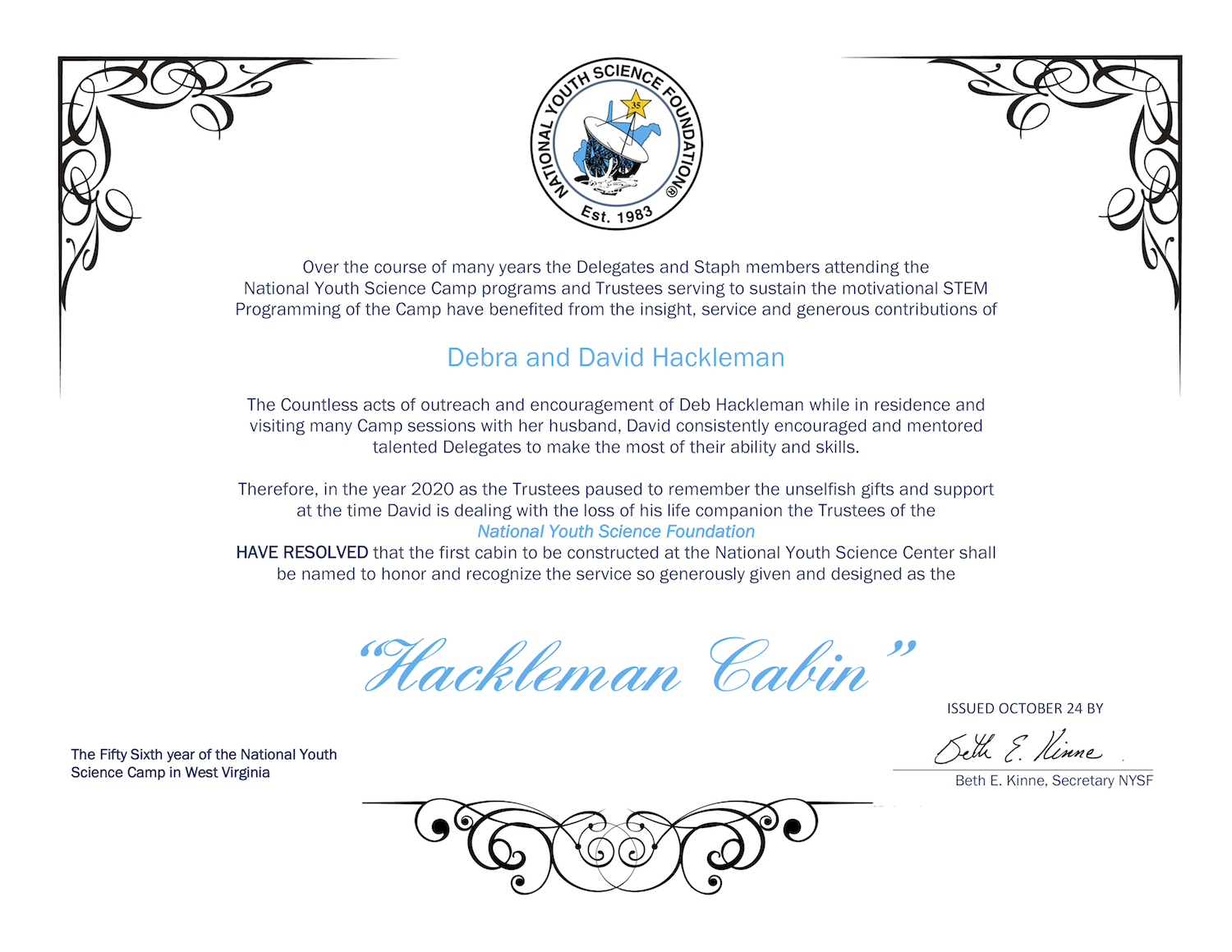
Dr. Isidore Adler
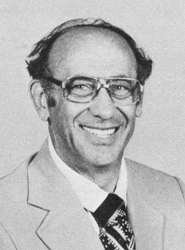
Isidore Adler was born in Brooklyn, NY on 25 December 1916 and married Annie in 1941. He obtained his AB from Brooklyn College in 1942, BS from NYU 1944, MS, and Ph.D. from the Polytechnic Institute of Brooklyn in 1947 and 1952 respectively. He worked for the US Customs lab and the US Signal Corps from 1937 through 1952, attaining 1st. Lt. rank. He then went to the US Geological Survey for 12 years. In the 60’s, the US Space program was beginning to become very promising. Izzy then became a project leader and then a Senior Scientist with NASA in 1964. Izzy attained a PhD in Physical Chemistry. He also had a degree in Metrology. During WWII, Izzy was a meteorologist with a bombing group in Italy during WWII. He was a senior scientist with NASA during the entire Apollo (Moon) program and was one of the selected people throughout the world to analyze the first “moon rocks”. He sent experiments with the Apollo 15 and 16 which for the first time in mankind’s history did a chemical analysis of the back of the Moon. By the way, this is a picture of Izzy at camp in 1978 after his lecture on the exploration of the Moon.
Izzy wrote and published three books:
- X-Ray Emission Spectrography in Geology – Methods in Geochemistry and Geophysics (1966, Elsevier)
- Physics and Chemistry in Space: Geochemical Exploration of the Moon and Planets (Springer-Verlag)
- The Analysis of Extraterrestrial Materials (1986, John Wiley & Sons)
Izzy published roughly 100 scientific articles over his career, was the recipient of many awards for his scientific accomplishments, acted as an associate editor on two scientific journals, a tour lecturer for the American Chemical Society as well as numerous invited lectures, Faculty member at the Institute on Man and Science and a Visiting lecturer/resident at the National Youth Science Camp.
Izzy loved teaching and being with young people. The University of Maryland offered him a full professorship with Tenure after the moon landing. Izzy assumed the position of Head of the Geochemistry Division. He retired from NASA and then spent thirteen years imparting his knowledge, humor, and ideologies to his adoring and eager students. The Public Television Series “The World of Chemistry” was directed by Izzy. With a team of distinguished scientists, it was funded by the Annenberg Foundation at the University of Maryland. It first aired in September of 1990, only six months after he succumbed on 26 March 1990 to the cancer diagnosed four and a half years earlier as terminal within two years. All the income from the sales of this series goes to the U. of Md. and the Annenberg Foundation.
Mr. Genji Endo

Mr. Genji Endo, a delegate to the 2006 Youth Science Leadership Institute representing the Dominican Republic, was killed on Sunday, September 18, 2011, in a traffic accident. According to news reports, Genji had a budding music career and an album was to be released in October.
Mr. Jonathon Hanson
Jonathon David Hanson, 21, of Elkview passed away unexpectedly on Tuesday, March 28, 2006, in Morgantown.
He graduated from Capital High School in 2003 with highest honors and straight A’s. He attended WVU as an honor student in the chemical engineering department with a 4.0 GPA. He made the dean’s list every semester while at WVU. He was a member of the National Society of Collegiate Scholars, Golden Key National Honor Society, and the Chemical Engineering Honorary. He was a member of the American Institute of Chemical Engineering and a member of the National Youth Science Foundation. He was a science fiction enthusiast with a love for Star Trek and was an amateur astronomer and photographer.
Surviving are his parents, David A. and Carolyn R. Hanson; sister, Jennifer L. Hansen; grandparents, Albert and Eleanor Westerhof of Auburn, Wash., and Ruth Caswell of Des Moines, Wash.; aunts and uncles, Diane and Paul Blough of Woodinville, Wash., and Barbara Roewe of Silver Creek, Wash.; cousins, Garrett, Alex, Chris, Matthew, and Shawn.
Professor Joseph McKee “Jutch” Hutchison III
December 4, 1931 – July 26, 2008
It is with great sadness that we convey news of the passing of Professor Joseph M. Hutchison III, Chairman Emeritus of the National Youth Science Foundation. Hutch died early on the morning of July 26, 2008, at his home in Morgantown, West Virginia, following a short illness.
For more than 45 years, Hutch worked diligently to promote and develop the National Youth Science Camp and advance the goals and objectives of the National Youth Science Foundation. He is survived by his wife and companion Ann who assisted him ably at the Camp for many years where he served as director and by his son Jay, daughters Suzanne and Katie, and several grandchildren.
Hutch received Foundation representatives this past Monday who presented him the certificate that designated a portion of the Foundation’s new Canaan Valley facility as the Joseph M. Hutchison Amphitheater. He was both moved and pleased with this recognition.
Professor Joseph ‘Hutch’ Hutchison has a long and notable tenure with the National Youth Science Camp and the Foundation. Along with Professor Chuck Cochran, Hutch was a key figure in the design and operation of the first National Youth Science Camp in 1963. Hutch directed the NYSC from 1971 to 1975 including the first coed year and played a critical role in many improvements to Camp Pocahontas’ physical plant, including renovations to the dining hall, lecture hall, and water plant.
For more than 10 years, Hutch served as Chairman of the Foundation’s Board of Trustees. During his tenure as Chairman, Hutch was instrumental in the selection of a site to construct the National Center for Youth Science Education near Davis in Tucker County, West Virginia, and directed the creation of two new programs (the Youth Science Leadership Institute and the West Virginia Governor’s School for Mathematics and Science).
This is difficult. Because only a few people are speaking here today, I feel that it falls to me to represent about 5000 science campers and staff members with my words. I also feel that I should try to represent thousands of undergraduate and graduate students whom Joe taught as well. You see, I was lucky. I got to be a part of Joe’s life in both of those contexts, and even more.
I met Joe Hutchison in 1963. I also met Ann then, and their two little children — Suzanne and Jay. I had to wait a few years before I met Katie, because she wasn’t even born yet! When I met the Hutchisons, they were camped in their trailer on the banks of Five Mile Run, just behind the Laura Dill Dining Hall at 4-H Camp Pocahontas in Pocahontas County. That was the site of the first National Youth Science Camp – which was the brainstorm of Joe and Chuck Cochran as a part of West Virginia’s Centennial Celebration. In fact, I’m wearing the blazer patch I received from them on the first day I met them when I arrived as one of the two delegates to the camp from the State of Iowa. Little did I know then at the age of 18 that I would come to know Joe and his family – and be welcomed by them without reservation – for the next 45 years, or that he would play such an important role in my life as a mentor, friend, and colleague – not only at the science camp, and in my graduate education at WVU, and even as a faculty colleague there, but also in the life of my family, and in countless other ways. My own son, Corey, was baptized in this church, and Joe stood up with us on that day.
Simply speaking, Joe had a tremendous influence on me, primarily through his delightful combination of quiet, under-spoken friendliness, humanity, and creative energy. I worked with him at the science camp for a total of 15 years, eventually becoming the director in the late 1980’s after he, Chuck Cochran, and Rod Wilson had retired from it. When I was the director, Joe was my model. I sought to follow his example in creating extraordinary programs and opportunities for young people considering careers in science. I got that part right in emulating him, but I just never learned how to play the left-handed banjo as he did, or to throw the left-handed Frisbee that’s in there with him! I could tell you countless stories from the science camp and from the School of Forestry about Joe, but to make things more concise, I thought I would simply tell you, with apologies to David Letterman, the Top Ten Things I Learned from Joe Hutchison.
Top Ten Things I learned from Joe Hutchison
#10. Take shortcuts!
If you want to get from Point A to Point B, take out a map, draw a straight line between the points, and take the nearest roads to the line you can find! For those of you who aren’t already laughing about this, let me explain – Joe was very adventurous and he did this stunt often, sometimes with disastrous results! Just ask Ann why Joe, Chuck, and Bob Slonneger took 24 hours to drive from Charleston to Marlinton. That “shortcut” took them up the bed of the Williams River!
#9. If you want to get somewhere for breakfast, you might just have to leave in the middle of the night to get there.
I hear some groans from his family on this one already! I personally remember one Thanksgiving week when Joe and I left for Chincoteague at 2am so we could be the first car into the wildlife refuge the next day. And I can guarantee that thousands of science campers remember the 3am wake-up call in order to drive from Pocahontas County to Washington DC in time for breakfast. You see, sleep wasn’t really all that important to Joe, but the adventure was.
#8. If you’re going to make something, make it special.
I remember when Joe wanted to build something at his house with flagstones. But they couldn’t just be any old flagstones. No, they had to be flat rocks from the West Virginia riverbeds of Pocahontas and Pendleton Counties. He and I spent several weekends taking “sorties” there to collect them. (“Sortie” is French for “ridiculous reconnaissance trip in a small car looking for adventure and large rocks.”) Altogether, we piled a couple of tons of river rocks into his trunk and eventually hauled them back to his house for his project. It was special!
#7. Immerse yourself in ideas – lots of them.
One of the reasons Joe and Chuck’s science camp was such a huge success from the beginning, and why it continues to be so today, is because they made it a place that welcomed and celebrated new ideas and new developments, not only in science but in many other fields as well – art, music, sports, religion, government – you name it. It was like a think-tank for gifted youth. We always said that the camp was a model for the way life should be everywhere, and we still believe it after 45 years. At WVU, Joe took his students on trips to visit New Towns and Utopian communities; he marveled at the interesting architecture, and he loved history and its connections to the present and the future. He never had enough of new ideas.
#6. Don’t let convention stand in your way.
Joe had lots of ideas for things to do, and he was willing to be unconventional. I’ve seen him backpack a huge reflecting telescope for miles to a remote campsite on a mountain-top, simply because the stars would be so clear up there; and I’ve seen him drag a generator to the top of Spruce Knob for a slideshow. After all, what better place for a slideshow after the sunset…? My own most favorite example of this was a science camp overnight hike we took to Panther Knob. If you haven’t heard of it, Panther Knob is near Circleville in Pendleton County, and it’s special because some really rare plant species grow on top of it. Joe and I took a botanist and a small group of young scientists there. The only thing was, there’s no hiking trail to it! We literally bushwhacked straight up the mountainside for about a mile (remember Point A and Point B!), we camped out among the plants at the top of the Knob that night, we ate wild blueberry pancakes up there in the morning, and then we practically rolled back downhill to go home. None of us will ever forget it, which is exactly what Joe wanted in the first place.
#5. The way to grade papers is to do it all at once!
I learned this while I was Joe’s graduate assistant in the Department of Recreation at WVU. Joe was the first professor I knew who required end-of-semester portfolios. I remember arriving at the end of each semester at the Hutchison house on Goodwin Hill with a huge load of students’ internship portfolios. We would start reading and grading on a Friday night and not quit until we were finished sometime on the following Monday afternoon. Ann supplied the coffee and the food while we holed up in the den and read papers until we turned blue. To this day, when finals week comes around at the university where I teach now, I still go into “Hutch mode.”
#4. Speed limit signs are just “suggestions.”
Anybody who has ever ridden with Joe on I-79, especially after dark, knows exactly what I’m talking about here. He would only slow down near Flatwoods, and you know why that was, too (daughter Suzanne lives there). A corollary to this is that the white lines along the side of any West Virginia highway are just suggestions, too…
#3. Country Roads are what it’s all about.
You’ve got to remember that the title of “Almost Heaven, West Virginia” is “Country Roads (take me home).” As far as Joe was concerned, there weren’t enough dirt roads in the world to keep him happy. Exploring them was always worth it, and he was more than willing to take off on one to see where it went, especially if he was driving some sort of 4-wheel drive vehicle. Perhaps some of you remember that one of his and Chuck’s fondest dreams was to take a trip called “Dirt Roads across America,” in which all progress from the Atlantic to the Pacific had to be made on a dirt road (although allowing travel north and south on pavement). It’s still a great idea for an adventure…
#2. It’s all in the Story.
Joe would talk to anybody – from senators and congressmen to bricklayers and bus drivers. He reveled in conversation and stories. He was always interested in people and what they had to say. He fell in love with the National Storytelling Festival in Jonesborough, Tennessee and he helped to start the one at Jackson’s Mill here in West Virginia. To him, a good story can teach us lots of things – about love, honor, deceit, enthusiasm, fate, and courage. And for that matter, every one of us has a story, and he liked to listen.
#1. Just treat people right, and the world will be a better place.
Joe was a very considerate and thoughtful man. He cared about others and how they felt. He performed countless acts of kindness – I know because I received many of them myself. He genuinely lived by the Golden Rule, and we all live in a better world because of it. In this sense, Joe was a deeply spiritual man – he was filled with spirit and with compassion.
Joe, we will miss you. For many of us, you were the spirit of the science camp, and the spirit of recreation at WVU. You were our guidepost. And you were the Mayor of Spruce Knob. You have left us all with a piece of your spirit, which we will treasure and extend to others. I guess we can say now that you have graduated – from “Almost Heaven” to “Heaven,” and I am sure that you and Chuck are exploring every country road that you can find up there. We pray that your soul will be at peace; we will all keep your spirit alive in ourselves. After all, it’s a good one to keep. Amen.
Pvt. Benjamin Cavender
Private Benjamin “Ben” Cavender, 22, of Charleston passed away Dec. 25, 2005, in Hawaii.
Born and raised in Big Chimney, he was a graduate of Capital High School’s class of 2002 and a member of the U.S. Army.
Surviving are his wife, Amanda Dawn Cavender; daughter, Hailie Dawn Cavender; parents, Michael and Angela Cavender of Big Chimney; sister, Amber Jean Cavender of Charleston; paternal grandparents, Orville and Carolyn Cavender; and maternal grandparent, Jean Morris.
Ghost of His Smile
Days careen
Like the waters of a rushing river
To the sea
And we know that he was doing all right
As the sun chased down another night
Here he comes again
Down the staircase
He never passes without whistling an optimistic tune
And we know that he was doing all right
As the sun chased down another night
I can’t forget the ghost
I can’t forget the ghost
I can’t forget the ghost
Of his smile
We knew that we loved you
Bud we did not know how much
We will never forget the ghost of your smile.
—
With heavy hearts, we write to tell you that Ben Cavender, known and loved by many at NYSCamp as Snake Boy, died unexpectedly this past Christmas Day. He was 22. He is survived by his wife Amanda, daughter Hailie, sister Amber, mother Angie (NYSCamp nurse 91-97), and father Mike. Angie, Amber, and Ben came to NYSCamp in 1991, and from the time Ben arrived at Camp Pocahontas, he explored every square inch of the grounds looking for snakes. He was tireless in his work as a young Nat Sci assistant.
Ben had recently joined the Army and was stationed in Hawaii for training. According to Angie, he was the happiest he had ever been. Ben’s love for nature and all creatures will live on in the hundreds he touched throughout his short life. Ben often noted how nice it was to be treated as an equal, not a kid, at Science Camp. Given his love for NYSCamp, his family asks that donations in his memory be made to the NYSF. Ben was buried January 8, 2006, in West Virginia.
Mr. Omar Ahmad
Omar Ahmad (FL 1982)
The National Youth Science Camp Delegation of 1982 has requested that the National Youth Science Foundation recognize contributions made in the memory of Omar Ahmad.
Donations made in the memory of Mr. Ahmad, include the following:
$1–$1000:
San Mateo County Transit District
Penisula Corridor Joint Power Board
Cantina Software
Ms. Amena Akmal
Mr. Troy Arnett
Ms. Donna Avanzino
Mr. and Mrs. Marco Babich
Ms. Annette Baird
Ms. Leah Berry
Dr. Andrew N. Blackwood and Ms. Holly M. Blackwood
Ms. Laurie Cudworth
Ms. Michelle Fraedrich
Mr. Robert Grassilli
Ms. Anne McDonough
Mr. Darrell Murray
Ms. Susan Raymond
Mr. Mark Sanicki
Mr. and Mrs. Frank Spevacek
Ms. Erica Umback
Ms. Stacey Wagner
Ms. Cynthia Wolloch
Contributions $1000 and above:
Mr. Steve Blasberg
Mrs. Semele Heller
From the Foundation’s Chairman, the Honorable Ronald G. Pearson: The National Youth Science Foundation received with great sadness the news that a loyal and prestigious alumnus, Omar Ahmad, died suddenly of a heart attack. Omar, like many of our alumni, gave unselfishly of his ideas, and energy to help the Foundation become a stronger organization at a critical point in its existence. He often provided ideas and encouragement to many NYSC Directors and to Foundation Trustees. He sought ways to strengthen the NYSCamp program and permit it to be able to reach more students each year. Most recently in July 2010, I had the pleasure of meeting with Omar in San Francisco and received his encouragement for plans the Foundation is considering to attract students from the Middle East to a new program. It is with great sadness that we acknowledge receipt of the news of his passing. I know that he will be missed by many of his fellow alumni and friends and his local community of San Carlos, California, where he served as Mayor.
Links of Note:
- Celebration of Life – San Carlos Mayor Omar Ahmad (Memorial Service Video)
- Article in The Daily Journal (May 14, 2011)
- (A)theologies
- The Daily Journal
- Article in The Daily Journal
- Profile on TED.com
- NBC News Article
- San Jose Mercury News
- San Francisco Examiner
- All Things Pakistan
- SanCarlosPatch
Dr. Eddie Koury
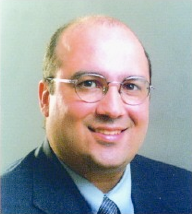
Dr. Eddie Koury was born in Trinidad and Tobago where he attended high school at Queen’s Royal College (QRC), a school with an enrollment of about 750 boys. He spent seven years at the school and was successful in his General Cambridge Certificate Advanced Level Exams for which he won a prestigious National Scholarship honoring the country’s top students. He obtained his Bachelor’s and Master’s degree in Chemical Engineering from Queens College, Cambridge University, England. He completed his Ph.D from MIT in 1996 and the findings from his thesis on “Drag Reduction by Polymer Solutions in Riblet Pipes” have been quoted in subsequent publications. He had presented his work both in America and Europe.
He returned to his native country where he worked initially in the oil industry and lectured in the Engineering Department at the University of the West Indies. In 2002 he founded his own company in which he developed and manufactured his own line of household cleaning agents. He was a recruiter for MIT and mentored students bound for that university as well as others. He was tragically killed in 2005 and in his memory, his family has established an award at QRC honoring the Most Improved Chemistry student. The Dr. Eddie Koury Memorial Award is honored to have its awardees attend the National Youth Science Camp and grateful for the support offered by the Science Camp.
Recipients:
- 2019: Jordel Benjamin
- 2018: Nicholas Raeburn
- 2017: Saif Farrag
- 2016: Andrew Mollineau
- 2015: Jeremiah John
- 2014: Kyl-John Nero
- 2013: Kyle Antoine
- 2012: Jivan Raghoo
- 2011: Akeen Matthews
- 2010: Jovanno Gould
- 2009: Joe Crooks
- 2008: Kercheval Ramoutar
- 2007: Marlon Boucaurd
Mr. Jose P. Gamarra
Jose P. Gamarra
1935-2015
Jose P. Gamarra was a scientist and invented things. He started discovering and inventing things at UCLA, when on a rainy day he came up with the idea of the permanent press (that was a long time ago). He later worked at Stanford Research Institute (SRI) and was Chief Staff Scientist at another research company. He enjoyed traveling to other countries and giving speeches about his new developments in research. He especially enjoyed getting young people interested in science.
Mr. Gamarra was born in Bolivia the son of a well-known and loved Doctor who was originally from Spain. He came to the US as a young man, became an American citizen, served in the US Army, had a lifelong career as a Bio-Chemist Scientist in California, and retired in Spain.
